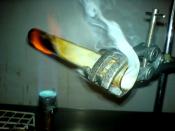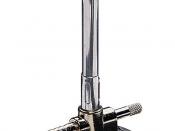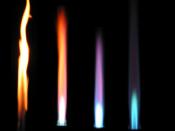AIM: To carry out a lab experiment to decompose a carbonate using heat, also to carry out appropriate tests for the formation of products as a result of this decomposition.
DISSCUSION: Carbonates are decomposed by heat into the corresponding oxides and carbon dioxide. The temperature of decomposition depends upon the activity of the metal; that is to say, the more active the metal, the more stable is the carbonate. Thus, the carbonates of sodium and potassium are stable at the highest temperature of a Bunsen burner flame, whereas the carbonates of silver and copper are easily decomposed. In this experiment copper (ii) carbonate will be decomposed at a high temperature, forming copper (ii) oxide and carbon dioxide:
CuCO3(s) arrow CuO(s) + CO2(g)
You will test for the formation of copper (ii) oxide and carbon dioxide. Limewater is a sensitive test for CO2, forming a distinctive milky precipitate:
CO2(g) + Ca(OH)2(aq) arrow CaCO3(s) + H2O(l)
APPARUTUS:
* fat Pyrex test tubes x 3
* medium Pyrex test tubes x 2
* holed stopper x 1
* bent glass delivery tube x 1
* rubber tubing x 1
* glass tubing x 1
* retort stand x 2
* Bunsen burner x 1
* Safety glasses x 1
* Copper(ii) carbonate
* Limewater
* Copper(ii) oxide
* 5ml of dilute H2SO4
METHOD:
1) Transfer a small quantity of CuCO3 equivalent to a depth of 1cm into a test tube
2) Clamp the test tube at an angle of 45 degrees and fit a stoppered delivery tube.
Immerse the end of the delivery tube into a test tube half-filled with limewater as shown in the diagram.
3) Heat the test tube containing the CuCO3 strongly for a few minutes until a colour change in the carbonate and lime water is observed
4) Record your observations of the changes occurring to the CuCO3 and the limewater
Testing for copper(ii) oxide
5) Allow the black powder (CuO) remaining in the test tube to cool
6) Add 5ml of dilute H2SO4 and warm gently with a Bunsen burner don't boil. Record your observations
7) Transfer small amount of pure CuO provided by your teacher into a test tube. Add 5ml of dilute H2SO4 and warm gently with a Bunsen burner don't boil. Record your observations
RISK ASSESMENT:
* the Bunsen is extremely hot and so is the test tube
* before you stop heating, remove the test tube containing, lime water
SAFETY PROCEDURES:
* wear safety glasses
* wear a lab coat
* use the wooden peg when handling the test tubes
RESULTS:
* CuCO3 turned black when heated
* When limewater joined to CO2 gas it turned milky
* When CuO was heated it turned blue
DISCUSION:
1) The principal component of limestone is the mineral calcite, but limestone frequently also contains the minerals dolomite (CaMg(CO3)2) and aragonite (CaCO3). Pure calcite, dolomite, and aragonite are clear or white. However, with impurities, they can take on a variety of colors. Consequently, limestone is commonly light colored; usually it is tan or gray. However, limestone has been found in almost every color. The color of limestone is due to impurities such as sand, clay, iron oxides and hydroxides, and organic materials. When treated with sulfuric acid, dolomite yields calcium sulfate (gypsum) and magnesium sulfate (Epsom salts). Calcined (heated) dolomite is extensively employed as a lining for Bessemer converters in the production of steel from pig iron.
2) Carbonate-hosted deposits are bodies of sphalerite, galena and iron sulphide (pyrite or marcasite) in limestone or dolostone. These deposits are also called Mississippi Valley-type deposits, since that part of North America has many of them. The deposits are generally believed to be formed when mineral-laden fluids travel through fractures or pore spaces in the rock. Chemical conditions in the carbonate rocks cause metals to precipitate from the fluids, to be deposited on fractures and in openings in the rock.
CONCLUSION: we saw that Carbonates are decomposed by heat into the corresponding oxides and carbon dioxide.


